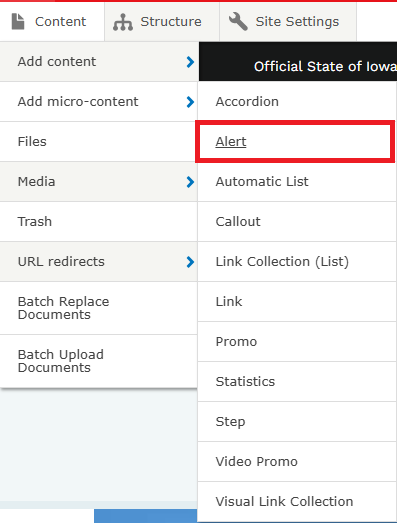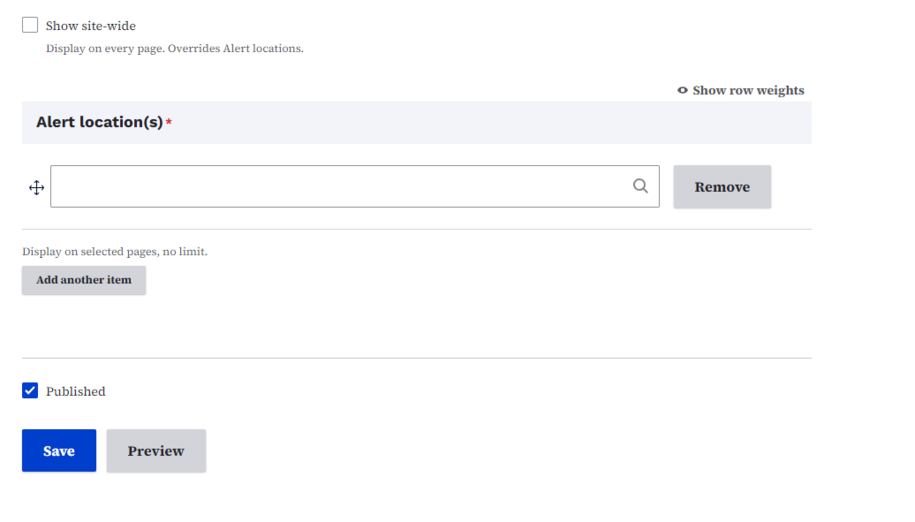Purpose
Alert microcontent helps share important info with website visitors quickly and directly.
When to use
Agency Content Managers can choose to show site-wide Alerts and display on every page, or within Alert location(s), choose specific pages to show the Alert. In the Alert location(s) box, start typing the name of a page where you'd like the Alert to be, then choose your page from the results. You can add more locations/pages, too.

Note: You can't change the status of an Alert (to Archive, for example) if the site-wide box is checked.
Elements of Alert microcontent
- Title - Limited to 50 characters, displays first in banner
- Details - Optional secondary banner text, limited to formatting, no links, limited to 175 characters
- Alert Type - Choose from notice or warning
- Link - URL and link text limited to 50 characters
- Authoring Information - Agency Managers use this to set a specific 'Created On' date for when an Alert appears as published
Alert best practices
Alerts are an effective way to make sure important content is seen. But that message gets lost if you ignore best practices.
- Set clear criteria for what qualifies as an Alert (urgency, relevance, impact).
- Target Alerts to relevant locations, avoiding irrelevant placements.
- Keep messages concise and easy to understand.
- Avoid overwhelming users with multiple stacked Alerts.
- Focus on the key information first. Then look for other ways to share less urgent messages.
- Remove Alerts promptly after the time-sensitive period has passed. This can be done with the Schedule Status Change feature, or you can manually Archive the Alert, or delete it.
Note: You can't change the status of an Alert (to Archive, for example) if the site-wide box is checked.

Alerts fields and settings:
- Title - Title of the alert displays first in the banner. Up to 50 characters. Required.
- Details - A space to provide brief details about the alert. Minimal text styling tools, including links. Up to 175 characters, which is one or two sentences.
- Alert type - Notice or warning. Required.
- Link - Link URL and link text for any link you provide for users to find out more. Link text is limited to 50 characters. Use this field to link to a full news post or basic page with further information about the Alert.
- Show site wide - Check this box to display the Alert on every page on the site. When this is checked, it overrides Alert locations.
- Alert locations - Enter the names of pages where you want to display the Alert. Use this field to target your Alert to specific site pages where it is relevant. No limit.
- Published - Check this box to publish the Alert. Published Alerts immediately display on the site. Uncheck it to unpublish the Alert. Unpublished Alerts do not display on the site.
- Published on Date - You can use this field, that is on the right side of the edit section of an Alert, to change the 'published on' date to be any date you would like.

Where to create an Alert
Go to your Microcontent section within your Content tab and find the Alert content.
Note: Users with agency access can create Alerts.

How to turn on an Alert
To turn on your Alert, set the Alert location. You can also click the show site wide button. This will make the Alert visible across the entire website, overriding the Alert location setting.

How to turn off an Alert
To turn off or remove an Alert, set the alert to Archive or delete the Alert.
Note: You can't change the status of an Alert (to Archive, for example) if the site-wide box is checked.
